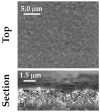Production Strategies of TiNx Coatings via Reactive High Power Impulse Magnetron Sputtering for Selective H2 Separation
- PMID: 34063392
- PMCID: PMC8156242
- DOI: 10.3390/membranes11050360
Production Strategies of TiNx Coatings via Reactive High Power Impulse Magnetron Sputtering for Selective H2 Separation
Abstract
This scientific work aims to optimize the preparation of titanium nitride coatings for selective H2 separation using the Reactive High Power Impulse Magnetron Sputtering technology (RHiPIMS). Currently, nitride-based thin films are considered promising membranes for hydrogen. The first series of TiNx/Si test samples were developed while changing the reactive gas percentage (N2%) during the process. Obtained coatings were extensively characterized in terms of morphology, composition, and microstructure. A 500 nm thick, dense TiNx coating was then deposited on a porous alumina substrate and widely investigated. Moreover, the as-prepared TiNx films were heat-treated in an atmosphere containing hydrogen in order to prove their chemical and structural stability; which revealed to be promising. This study highlighted how the RHiPIMS method permits fine control of the grown layer's stoichiometry and microstructure. Moreover, it pointed out the need for a protective layer to prevent surface oxidation of the nitride membrane by air and the necessity to deepen the study of TiNx/alumina interface in order to improve film/substrate adhesion.
Keywords: TiNx film membranes; chemical robustness under h2; high power impulse magnetron sputtering; porous ceramic substrates.
Conflict of interest statement
The authors declare no conflict of interest.
Figures










References
-
- Gallucci F., Fernandez E., Corengia P., Annaland M. Recent advances on membranes and membrane reactors for hydrogen production. Chem. Eng. Sci. 2013;92:40–66. doi: 10.1016/j.ces.2013.01.008. - DOI
-
- Al-Mufachi N.A., Rees N.V., Steinberger-Wilkens R. Hydrogen selective membranes: A review of palladium-based dense metal membranes. Renew. Sustain. Energ. Rev. 2015;47:540–551. doi: 10.1016/j.rser.2015.03.026. - DOI
-
- Barison S., Fasolin S., Boldrini S., Ferrario A., Romano M., Montagner F., Deambrosis S.M., Fabrizio M., Armelao L. PdAg/alumina membranes prepared by high power impulse magnetron sputtering for hydrogen separation. Int. J. Hydrogen Energy. 2018;43:7982–7989. doi: 10.1016/j.ijhydene.2018.03.065. - DOI
-
- [(accessed on 27 April 2021)]; Available online: https://www.kitco.com/charts/livepalladium.html.
-
- Meulenberg W.A., Schulze-Küppers F., Deibert W., Van Gestel T., Baumann S. Ceramic Membranes: Materials—Components—Potential Applications. ChemBioEng Rev. 2019;6:198–208. doi: 10.1002/cben.201900022. - DOI
LinkOut - more resources
Full Text Sources

